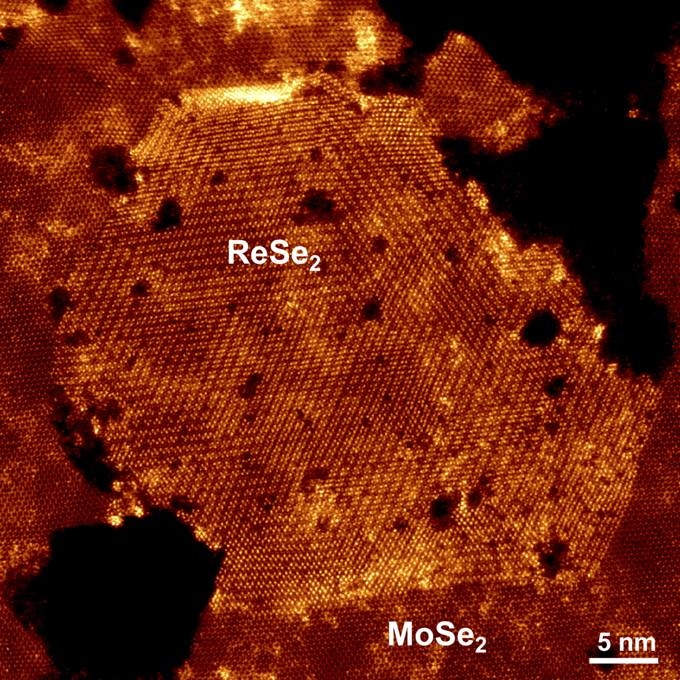Aug 13 2019
Researchers at a Rice University lab are working towards making products look sharp, even at the nanoscale. The lab’s newest creation is spot on.
 Adjacent crystal structures of rhenium diselenide (top) and molybdenum diselenide form a 2D transition metal dichalcogenide heterostructure with sharply separated domains. The unique material created at Rice University shows promise for optoelectronic applications. (Courtesy of the Center for Nanophase Materials Science and the Ajayan Research Group)
Adjacent crystal structures of rhenium diselenide (top) and molybdenum diselenide form a 2D transition metal dichalcogenide heterostructure with sharply separated domains. The unique material created at Rice University shows promise for optoelectronic applications. (Courtesy of the Center for Nanophase Materials Science and the Ajayan Research Group)
The Rice lab of materials scientist Pulickel Ajayan has developed exclusive two-dimensional (2D) flakes with two diverse personalities: molybdenum diselenide forming one side of a sharp divide with rhenium diselenide on the other.
From the looks of it, the two-toned material likes it that way, growing naturally — though under tight circumstances — in a chemical vapor deposition furnace.
The material is a 2D transition metal dichalcogenide heterostructure, a crystal with more than one chemical element. That is not uncommon in itself, but the sharp zigzag boundary between elements in the material described in the American Chemical Society journal Nano Letters is distinctive.
Dichalcogenides are semiconductors that include transition metals and chalcogens. They are a favorable component for optoelectronic applications such as photodetectors, solar cells, and sensing devices. Lead author Amey Apte, a Rice graduate student, said they may also be ideal materials for neuromorphic computing or quantum computing, which imitates the structure of the human brain.
Apte said well-recognized, atomically flat molybdenum-tungsten dichalcogenide heterostructures can be more alloy-like, with diffuse boundaries between their crystal domains. However, the new material — in principle, 2H MoSe2-1T’ ReSe2 — consists of atomically sharp interfaces that give it a smaller electronic bandgap than other dichalcogenides.
Instead of having one unique bandgap based on the composition of an alloy, we can tune the bandgap in this material in a very controllable way. The strong dissimilarity between two adjacent atomically thin domains opens up new avenues.
Amey Apte, Study Lead author and Graduate Student, Rice University
He said the range of voltages was mostly between 1.5 and 2.5 electron volts.
Growing the materials dependably involved the formation of a phase diagram that prescribed how each parameter — the temperature, the balance of chemical gas precursor, and the time — influences the process. Rice graduate student and co-author Sandhya Susarla said the diagram acts as a road map for manufacturers.
The biggest issue in these 2D materials has been that they’re not very reproducible. They’re very sensitive to a lot of parameters, because the process is kinetically controlled. But our process is scalable because it’s thermodynamically controlled. Manufacturers don’t have a lot of parameters to look at. They just have to look at the phase diagram, control the composition and they will get the product every time.
Sandhya Susarla, Study Co-Author and Graduate Student, Rice University
The scientists believe they can gain more control of the material’s form by altering the substrate for epitaxial growth. Having the atoms settle into place in keeping with the surface’s own atomic set up would enable greater customization.
The co-authors of the paper include Rice graduate student Lucas Sassi; former postdoctoral researcher Jongwon Yoon, currently a senior researcher at the Korea Basic Science Institute; Palash Bharadwaj, the Texas Instruments Assistant Professor of Electrical and Computer Engineering; alumnus Chandra Sekhar Tiwary, at present an assistant professor at the Indian Institute of Technology, Kharagpur; and James Tour, the T.T. and W.F. Chao Chair in Chemistry, a professor of computer science and of materials science and nanoengineering; Aravind Krishnamoorthy, Rajiv Kalia, Aiichiro Nakano and Priya Vashishta of the University of Southern California and Jordan Hachtel and Juan Carlos Idrobo of Oak Ridge National Laboratory.
Ajayan is chair of Rice’s Department of Materials Science and NanoEngineering, the Benjamin M. and Mary Greenwood Anderson Professor in Engineering and a professor of chemistry.
The study was supported by the Department of Energy, Office of Science, Basic Energy Sciences and the Air Force Office of Scientific Research.